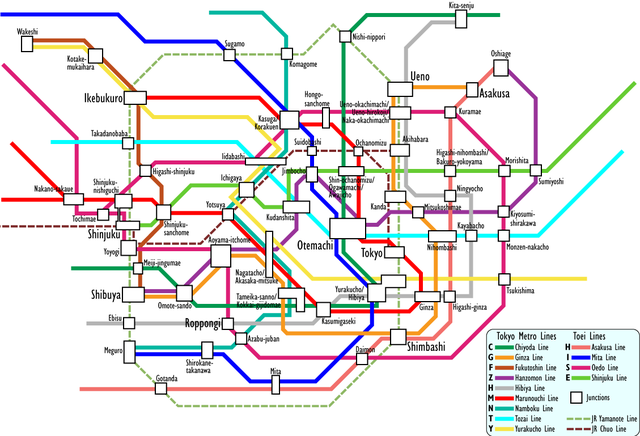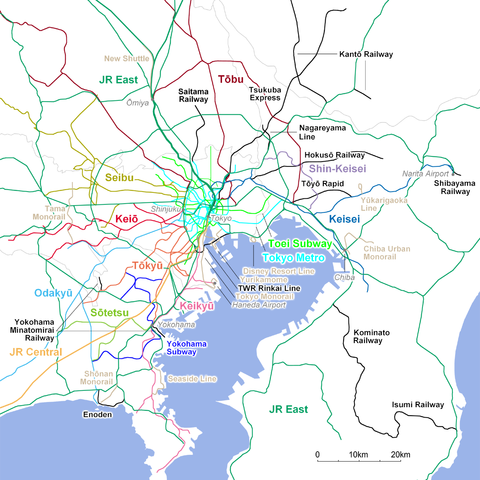First, we'll talk about the train lines owned by JR East, the major rail company of eastern Japan.
 |
| A map of the Yamanote Line and surrounding JR East lines. RailRider [CC BY-SA 3.0 or GFDL], via Wikimedia Commons |
| Name (English) | Name (Japanese) | Colour | Areas Served |
| Yamanote | 山手線 | Light green | Tokyo Station, Shimbashi, Shinagawa, Shibuya, Shinjuku, Ikebukuro, Ueno, Akihabara |
| Chuo (Rapid) | 中央線快速 | Orange | Tokyo Station, Shinjuku, Nakano, Ghibli Museum, Mt. Takao |
| Chuo-Sobu (Local) | 中央・総武緩行線 | Yellow | Akihabara, Tokyo Dome, Shinjuku, Nakano, Ghibli Museum |
| Keihin-Tohoku | 京浜東北線 | Light blue | Saitama, Ueno, Akihabara, Tokyo Station, Shimbashi, Shinagawa, Kawasaki, Yokohama |
| Saikyo | 埼京線 | Dark green | Shibuya, Shinjuku, Ikebukuro, Saitama |
| Tokaido Main Line | 東海道本線 | Orange | Tokyo Station, Shimbashi, Shinagawa, Kawasaki, Yokohama |
| Keiyo | 京葉線 | Red | Tokyo Station, Tokyo Disney Resort, Chiba |
| Sobu (Rapid) | 総武快速線 | Dark blue | Tokyo Station, Chiba, Narita Airport |
| Yokosuka | 横須賀線 | Dark blue | Tokyo Station, Shimbashi, Shinagawa, Kawasaki, Yokohama, Kamakura |
| Shonan-Shinjuku* | 湘南新宿ライン | Red | Kamakura, Yokohama, Kawasaki, Shibuya, Shinjuku, Ikebukuro, Saitama |
Of these, the most useful to beginner tourists will be the Yamanote (JY) line, which runs in a loop around central Tokyo and has stations at many of the city's major points of interest. If you can't memorise the name, you can identify it by its bright green label colour. It is cheap, with tickets starting at 140 for the first few stations, and frequent, with trains arriving every 3-5 minutes. Most of JR East's lines in the area connect with the Yamanote line at certain points, as do all of the subway lines and other private railways. This includes the JR-run high-speed Shinkansen; the Tokaido line stops at Tokyo and Shinagawa, and the northern lines (Tohoku, Joetsu, Hokuriku, etc.) stop at Tokyo and Ueno. So, not only is the Yamanote line a good way to get around, but serves as a useful starting point for understanding the area itself.
The other lines head outwards from the Yamanote loop to suburban regions and beyond. All of the above lines are free to use with the Japan Rail pass and other area passes offered by JR East. One other line I'd like to point out is the Chuo Line, which bisects the Yamanote loop from east to west. There are actually two kinds of services which run on the Chuo Line: the Rapid (JC) trains make fewer stops in city limits and end at Tokyo Station, and the Local (JB) trains stop at every station and diverge from the Chuo line proper, crossing the Yamanote loop at Akihabara station, and later merging onto the Sobu line east of Tokyo. Fortunately, it is easy to tell them apart, as the Rapid and Local trains are labelled with different colours (orange for Rapid, yellow for Local), and stop at separate platforms on stations which serve both.
The problem is that there are a number of destinations which cannot be accessed by the Yamanote loop or even other JR lines. For that, our next step is to layer on the subway lines.
 |
| A map of the Tokyo Metro and Toei subway networks. User: (WT-shared) Dguillaime at wts wikivoyage [Public domain], from Wikimedia Commons |
| Name (English) | Name (Japanese) | Operator | Colour | Transfers with Yamanote Line |
| Ginza | 銀座線 | Tokyo Metro | Orange | Ueno, Okachimachi/Ueno-Hirokoji, Akihabara/Suehirocho, Shimbashi, Shibuya |
| Marunouchi | 丸ノ内線 | Tokyo Metro | Red | Shinjuku, Tokyo, Ikebukuro |
| Hibiya | 日比谷線 | Tokyo Metro | Grey | Ueno, Okachimachi/Naka-Okachimachi, Akihabara, Yurakucho/Hibiya, Ebisu |
| Tozai | 東西線 | Tokyo Metro | Light blue | Takadanobaba, Tokyo/Otemachi |
| Chiyoda | 千代田線 | Tokyo Metro | Green | Harajuku/Meiji Jingu-mae, Tokyo/Otemachi, Nishi-Nippori |
| Yurakucho | 有楽町線 | Tokyo Metro | Yellow | Yurakucho, Ikebukuro |
| Hanzomon | 半蔵門線 | Tokyo Metro | Violet | Tokyo/Otemachi, Shibuya |
| Namboku | 南北線 | Tokyo Metro | Teal | Meguro, Komagome |
| Fukutoshin | 副都心線 | Tokyo Metro | Brown | Shibuya, Harajuku/Meiji Jingu-mae, Ikebukuro |
| Asakusa | 浅草線 | Toei | Pink | Gotanda, Hamamatsu-cho/Daimon, Shimbashi/Shiodome |
| Mita | 三田線 | Toei | Blue | Meguro, Sugamo |
| Shinjuku | 新宿線 | Toei | Light green | Shinjuku, Akihabara/Iwamoto-cho |
| Oedo | 大江戸線 | Toei | Dark pink | Shinjuku, Okachimachi/Ueno-Okachimachi, Hamamatsu-cho/Daimon, Yoyogi |
Two companies operate subway lines in Tokyo: the private Tokyo Metro, and the city government Toei, but both companies' lines are usually shown on maps together. Their fares are comparable to the Yamanote and other such lines. At some stations it is possible to transfer between Tokyo Metro and Toei lines, but a second ticket or a special transfer ticket is required. If you are using an IC debit card like Suica or Pasmo, this is handled automatically. Some subway trains also continue onto other JR or private lines. For example, the "Airport Limited Express" service on the Toei Asakusa (A) line has through-service to Narita Airport on one end, via Keisei's lines, and Haneda Airport on the other, via Keikyu's lines.
The JR Pass cannot be used with any subway lines, but both Tokyo Metro and Toei sell their own free passes. The best value for foreign tourists is the Tokyo Subway Ticket, which allows free use of all 13 subway lines across both companies. Unlike most passes, they are sold in 24-hour (¥800), 48-hour (¥1,200), and 72-hour (¥1,500) varieties, which means you can start using one at 6:00 PM, for example, and it would be valid until 6PM the next day. This can be a major advantage, especially if you're coming into the city in the afternoon. The Tokyo Subway Ticket pass is available for purchase at Narita and Haneda Airports, and at Bic Camera, Sofmap, and Don Quijote stores across the city. Like the Japan Rail Pass, this pass is only sold to overseas visitors, so please have your passport on hand before purchasing. More information: (English)
Next, we'll cover the other private rail companies.
 |
| A map of all rail lines in the greater Tokyo area. FML [GFDL or CC BY-SA 3.0], from Wikimedia Commons |
| Name (English) | Name (Japanese) | Transfers with Yamanote Line |
Areas Served |
| Keikyu | 京急 | Shinagawa | Haneda Airport, Yokohama, Kanagawa Prefecture |
| Keio | 京王 | Shibuya, Shinjuku | Mt. Takao, Western Tokyo |
| Keisei | 京成 | Ueno, Nippori | Narita Airport, Chiba Prefecture |
| Odakyu | 小田急 | Shinjuku | Odawara, Enoshima |
| Rinkai Line | りんかい線 | Osaki | Odaiba |
| Seibu | 西武 | Shinjuku, Ikebukuro | Kawagoe, Western Tokyo |
| Tobu | 東武 | Asakusa, Ikebukuro | Nikko, Kinugawa Onsen, Kawagoe, Saitama Prefecture |
| Tokyo Monorail | 東京モノレール | Hamamatsu-cho | Haneda Airport |
| Tokyu | 東急 | Shibuya | Yokohama, Kanagawa Prefecture |
| Tsukuba Express | つくばエクスプレッス | Akihabara | Tsukuba, Ibaraki Prefecture |
| Yurikamome | ゆりかもめ | Shimbashi | Odaiba |
For the most part, these lines serve commuters in suburban regions of Tokyo. A few of these lines, however, also provide convenient access to outlying tourist destinations, such as Yokohama, Kamakura, and Nikko, as well as Narita and Haneda Airports. There are even limited express services available on certain Keisei, Odakyu, and Tobu lines for additional speed and comfort. JR Passes cannot be used on these private lines, with a few exceptions. For example, the Tokyo Monorail is covered by the Japan Rail Pass, and the Tokyo Wide Area Pass covers it, the Rinkai Line, and Tobu trains to Nikko and Kinugawa Onsen. Please review the coverage details of each pass to determine which one is right for you.
Tips
Tips
- JR East offers a few one-day passes covering the central Tokyo area, specifically the main 23 metropolitan wards. The Tokyo Metropolitan District Pass (a.k.a. Tokunai Pass) covers regular JR East lines within the area, including the whole Yamanote line loop. However, a few tourist destinations lie just outside of its reach, such as Tokyo Disney Resort, the Ghibli Museum, and Asakusa. It costs ¥750, which will pay for itself in 4 to 5 rides, and is available from reserved-seat ticket machines. More information: (English)
- Another day pass offered by JR East is the Tokyo 1-Day Ticket (a.k.a. Tokyo Free Kippu), which covers all JR East, Tokyo Metro, and Toei lines within the 23 wards area. It costs ¥1,590, however, making it a bit too expensive to be of value. More information: (English)
- Just as cars drive on the left side of the roads in Japan, so do trains run on left-hand tracks. This is a good rule-of-thumb to keep in mind, to make sure the train you board is heading in your desired direction.
- The Oedo (E) line is the deepest subway line in all of Tokyo (48m / 157.5ft at most), so if you will be using it, give yourself an extra couple of minutes to head down to and back from the platforms.
- The Ginza (G) line was the first subway line opened in Asia. The first section, between Ueno and Asakusa, opened in 1927. It was extended to its current length in 1941, terminating at Shibuya,
- The Oedo (E) line was fully opened on 12 December 2000. On the Japanese imperial calendar, which restarts at year one when a new emperor ascends to power, this date can also be written as 12/12/12. AD 2000 was the 12th year of the Heisei era, which began with the reign of Emperor Akihito in 1989.
